

The Durachrome Bug
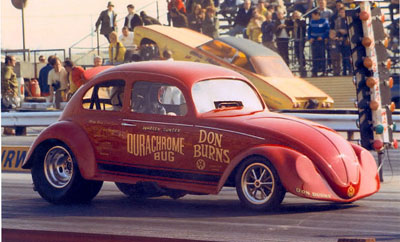
Warren Gunter's Durachrome Bug Funny Car of the late 1960s and early 1970s was emblematic of the class' evolving nature; no experiment or idea was too radical, no gimmick too out there in the pursuit of bookings and fan interest.
|
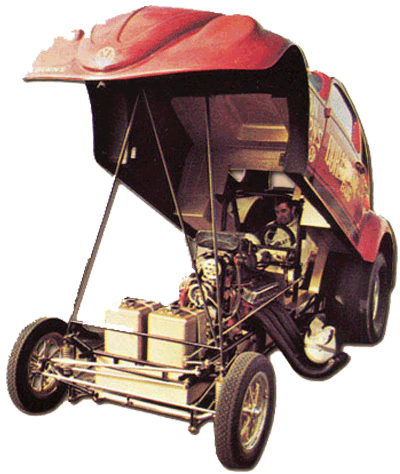 |
The late 1960s was an interesting time for the Funny Car class. The fledgling category was coming into its own, and racetrack operators were discovering that more than just Top Fuelers would sell tickets.
It was a highly experimental era, when teams were finding out — often the hard way — what didn’t work as often as what did, and everyone had his own idea about what might be "the next big thing." For many of those early flopper racers, when it came to getting match race bookings, standing out was as important as standing up, and we saw crazy cars such as Roger Wolford’s Secret Weapon Jeep and Doug Nash's Ford Bronco.
If you frequented SoCal tracks in those days, undoubtedly one of the most popular and well-remembered Funny Cars of the era was Warren Gunter's Durachrome Bug. The stretched VW shell, with Gunter in the back seat and the engine in the "front seat” of the Mike Kase-chassised machine, never failed to bring the fans to their feet. The car was sponsored by Southern California VW accessories giant Durachrome and co-sponsored by Don Burns' VW dealership; powered by a nitro-burning Chevy, it ran into the 7.0s at 210 mph.
While working on Tuesday's G edition of the Misc. Files, I tracked down Gunter through LinkedIn and spoke to him earlier this week. He has nothing but great memories of his short time in the spotlight, touring the country and racing his unique machine.
The first thing everyone wants to know is “Why a VW?”
Gunter originally had an injected big-block Chevy-powered, steel-bodied Model T coupe that ran in the Jr. Fuel Altered class. When he contemplated stepping up to the full-on Fuel Altered class, "everyone was running the Fiat Topolino body; I thought to myself, 'What can I build that's just as streamlined but a little different?' "
Gunter found a fiberglass company in Southern California's San Fernando Valley that had a VW Bug mold and began building his dream car, a Funny Car-style fuel altered, complete with automatic transmission and suspension, patterned after the Gunter Bros. altered.
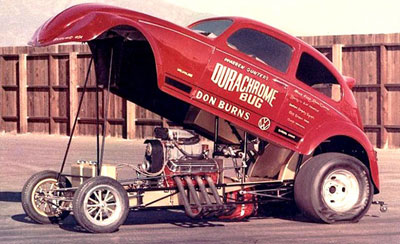
Two Durachrome Bug chassis were built. The first (above), easily identifiable by the 12-spoke wheels, had altered origins with a suspension.
|
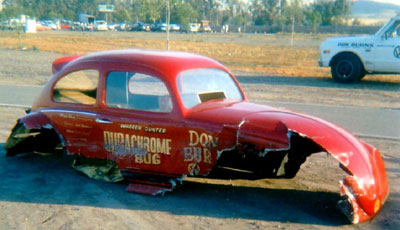
(Above) The first car was a real handful -- "spooky" Gunter called it -- and ended up crashing into the guardrail at OCIR. (Below) The body was saved and a new chassis was built, identifiable by the five-spoke wheels.
|
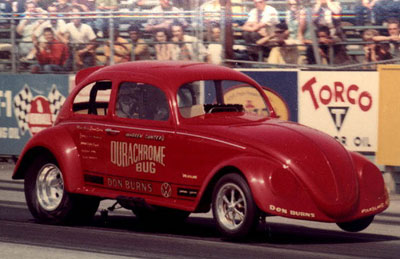 |
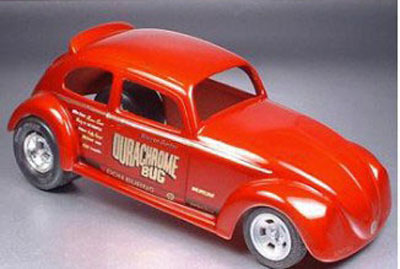
The Durachrome Bug's following continues today as model builders create their own using other kits and doing extensive stretching to once-stock Bug bodies.
|
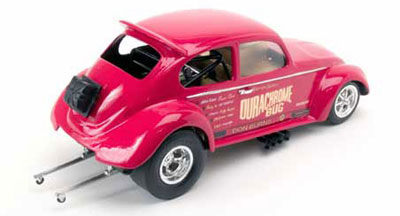 |
"At the time, my Model T could beat those blown Chryslers because they were smoking the tires the whole way down the strip, and my car was more consistent," he said. "I knew a guy at Fiberglass Trends, and we took the body and narrowed it and stretched it and added running boards, and somewhere along the way, I decided it should be a Funny Car instead, so we moved the engine back a bit." Gunter traded for a blown engine and went Funny Car racing.
"It was really a pretty car; I hate to pat myself on the back, but I did all of the sheet metal, which I had gold-anodized, and all the painting," he said. "VWs were very popular then because of Herbie in that movie The Love Bug.
"I found Durachrome through an ad in Hot Rod magazine, and I took the car out to their business on a trailer, and they loved it," he said. "With that and the Don Burns sponsorship, I was able to race the car for a few years and even toured back East. I raced local for the first year or so, then started getting some bookings back East. I spent two summers in Geneva, Ohio, on Lake Erie sharing a garage with Paula Murphy and using that as a home base for touring.”
There were actually two Durachrome Bugs built, distinguishable by their front wheels. The first version, which had 12-spoke wheels, was built on an altered chassis. The second car, which had five-spoke wheels, had more of a Funny Car chassis.
"The first car seldom would make a hard straight run," he admitted. "With the automatic transmission, the wheelie bars, and the suspension, it would get pretty squirrelly. It would always take a real bad jog about half-track. I never could figure out if it was aerodynamics or what because the car was pretty stable at the top end. I even tracked down some old German wind-tunnel testing that was done on the car, and that shape has a tendency to lift the rear end only at a certain speed, so it was some sort of a transitional thing. It was a pretty spooky car.
"We got it better by the time of the second car, which had a two-speed and a clutch in it, and it became more consistent."
The bottom dropped out very suddenly for Gunter when Durachrome suddenly went out of business in the early 1970s and he couldn't find a replacement sponsor.
"I sold the car and heard it ended up in Oregon or Washington," he said. "Once I figured I wasn't going to make a living at it, I knew it was time to give it up. I had paid for the first car myself and couldn’t see doing that over and over. I just went on with my life and into other things.”
Just as he lost his sponsor, he was called back to work in his previous career, in the aviation and aerospace industry, and spent 22 years as a thermal engineer at Rockwell, working on military spy satellites. From 1978 to 2000, he also owned the San Pedro Jewelry Mart in Southern California, and, as he has since his Funny Car days, he runs P&M Management, a real-estate company, and has a sport-fishing boat.
"I haven’t been out to the races for quite a while," he said, "but I still follow it on TV and on the Web site. I also watch eBay for handouts of the car and find all sorts of photos of the car on the Internet. There also have been some model builders who have done some spectacular models of the car by putting things together from other kits. It's great to be so well-remembered.
"What great memories," he added. "I look back on that, and it was a great time."

I'm not sure how many of you might have caught the posting yesterday in the NHRA.com Notebook about the passing of longtime photographer Eric Brooks. Although Eric's work might have been known regionally in the Southeast where he was a veteran track photographer, you might not have known him unless you were a class racer, and if you were a class racer, you were very happy to meet him because it was his face that you saw when you went to have your photo taken after winning class at the Mac Tools U.S. Nationals presented by Lucas Oil, one of the great accomplishments in any Sportsman racer's career.
.jpg) |
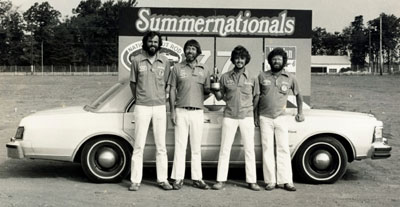 |
Eric Paul Brooks shot for National DRAGSTER for years, sometimes helping the national event team but mostly spending enjoyable time down in the secondary winner's circle in Indy, which is just behind the return road, just past the finish line. It was there that I first met Eric, at the 1983 SPORTSnationals, which that year was being held in Indy. The photo at right is from that day, where we thought it would be funny to have EPB on the other side of the lens. That's me on the far left, next to Eric. To his left is former ad sales guy Chris Hawley, a great guy who was my constant roomie in those early days on the road. At the far right, of course, is Leslie Lovett.
The second photo shows that we were't all that original in 1983, as the guys had done a similar shot in Englishtown in 1977, with still-active ND shooter Richard Brady, far left, and our ol' pal Bill Crites, far right, in place of me and Chris.
Looking at this second pic, it's sad that we've lost three of the four, yet also oddly reassuring that they've been reunited someplace else. We'll miss ya, Eric. Godspeed.



















































